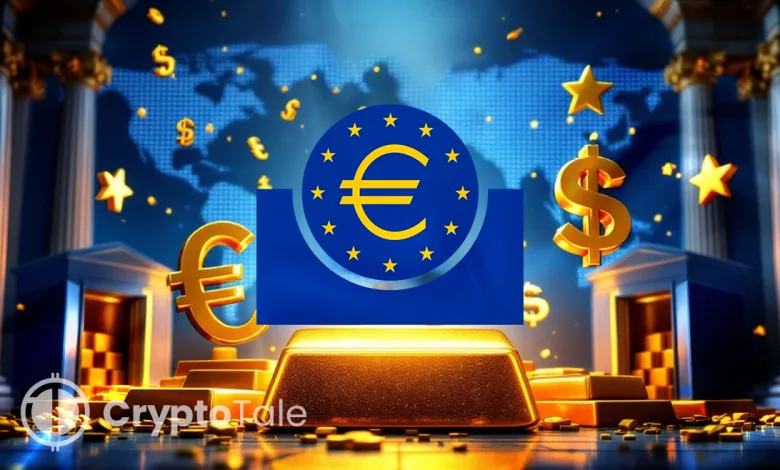Are US Dollar Stablecoins Undermining Europe’s Monetary Sovereignty?

- ECB warns US dollar-backed stablecoins threaten the euro’s monetary sovereignty.
- Schaaf urges Europe to adopt euro-pegged stablecoins and improve global regulation.
- ECB pushes for digital euro and DLT projects to strengthen Europe’s financial infrastructure.
The European Central Bank (ECB) has raised a warning about the growing dominance of US dollar-backed stablecoins. The ECB believes this trend poses a serious threat to the euro’s monetary autonomy. Jürgen Schaaf, an adviser to the ECB, stressed that the rise of dollar-pegged stablecoins challenges Europe’s ability to influence its financial policies effectively.
Schaaf argued that a central bank digital currency (CBDC) alone will not be enough to counter the impact of dollar-backed stablecoins. He recommended a more strategic approach, including the use of euro-pegged stablecoins, to combat this issue. These stablecoins could offer an alternative to US-backed digital currencies and help maintain the euro’s influence globally.
ECB Urges Stronger Regulation
In addition to euro-pegged stablecoins, Schaaf pointed to the need for better regulation. He called for more global coordination on stablecoin regulation to address the growing regulatory gaps between the US and the EU. These differences, Schaaf warned, may allow dollar-pegged stablecoins to expand unchecked, further strengthening their global position.
While the digital euro is central to Europe’s strategy, Schaaf cautioned that it may not be enough to face the challenge posed by US dollar-pegged stablecoins. He emphasized the importance of a comprehensive strategy, which includes leveraging distributed ledger technology (DLT) applications to improve Europe’s financial infrastructure.
DLT can enhance both domestic and cross-border payment systems. The ECB has already approved two DLT pilot projects—Pontes and Appia—designed to strengthen Europe’s wholesale and cross-border payment networks. Schaaf believes these projects can help Europe remain competitive against US dollar-backed stablecoins.
The rise of US dollar-pegged stablecoins has become a major concern for European policymakers. The concern grew after an executive order by US President Donald Trump, which aimed to increase the US dollar’s global dominance. Since then, dollar-pegged stablecoins have grown quickly, which could undermine Europe’s financial independence.
Euro-Pegged Stablecoins for Financial Stability
According to Schaaf, the EU needs to take a prompt move to safeguard its monetary independence. He suggested that Europe should focus on the creation of euro-pegged stablecoins. Such euro-backed stablecoins may create an alternative, competitive line of US dollar-pegged stablecoins and support euro international financial reputation.
Slow pace adoption of euro-pegged stablecoins has been seen despite the efforts of the EU through its MiCA regulation. Past research has revealed that circulation of such stablecoins has been minimal. To speed up acceptance, to serve market needs well and reduce financial risks, the euro-pegged stablecoins should meet high standards.
Related: 21Shares Taps Societe Generale to Boost EU Crypto ETP Liquidity
Stablecoins supplied by Euro may bring equilibrium in the digital currency market. They would protect the presence of the euro on the international financial market, offering a reliable alternative to stablecoins backed by the US. Nevertheless, Europe needs to develop a powerful regulation system and promote its use in order to make them successful.
The digital euro has also kept focus on the reactions to the rising dominance of US stablecoins. Schaaf considers digital euro as a means to ensure financial independence of the eurozone. However, he considers that the digital euro needs to be included into a more comprehensive approach which also promotes innovation in the private sector and the adoption of the DLT applications.
The digital euro forms part of Europe as a counter to the US stablecoins. Some ECB officials, such as Piero Cipollone, believe that it has the potential to save the monetary sovereignty of the eurozone. Nonetheless, since going into its “preparation phase” in November 2023, the ECB is still undecided on whether it will launch and may be expected to reach a decision by the end of 2025.
The growing dominance of US dollar-backed stablecoins poses a significant threat to the euro’s monetary sovereignty. Europe needs to take immediate and resolute measures in order to safeguard their financial independence. Euro-pegged stablecoins, the digital euro, and stronger regulation will protect Europe as these steps are vital in a rapidly changing global market.




